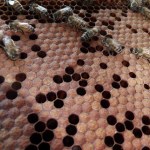bees
Today's bug news carries sensational reports of a study claiming new evidence linking cell phone use and the dreaded Colony Collapse Disorder.
London, England (CNN) -- A new study has suggested that cell phone radiation may be contributing to declines in bee populations in some areas of the world. Bee populations dropped 17 percent in the UK last year, according to the British Bee Association, and nearly 30 percent in the United States says the U.S. Department of Agriculture.
This bit of silliness resurrects a fanciful hypothesis first raised when honey bees started disappearing a couple…
What were those magical mystery circles cut into leaf margins, and who made them?
As so many of you recognized, they were the marks of leafcutter bees, furry little insects that use the leaves to make nests for their young.
For their correct answers, MrILoveTheAnts gets 5 points, and James Trager gets five points. And Tonya & Hp each get a point for making me laugh.
Yes, another of those posts about the tedious details of my life that you care nothing about. And also an advert for my honey, hurrah.
In the middle you'll see my beehive. I've finally done most of the honey-related stuff this year (see-also previous bee blogging) so if you live nearby and care to purchase some finest quality Stoat honey with only a few bits of dead bee in it, please email. This year it does seem to be rape, judging by the speed at which it sets. The "comedy" aspect of the beekeeping was the way I managed to stumble around knocking the supers nearly off as I tried to get the…
You may have noticed I've been blogging rather lightly in recent weeks. That's because I start teaching an introductory course on beekeeping next Monday. It'll be a great class, I hope. But the preparation has cut into blogging time something fierce and will continue to do so through August.
In any case, while making lecture slides yesterday I ran into trouble locating a figure depicting the native range of Apis mellifera. You'd think someone would have posted one, somewhere. The western honey bee is the world's most economically important insect, introduced nearly everywhere where humans…
We' re recently acquired the second half of that vital twosome, the cat, to complement our Roomba. And so, here is a picture of our cat, Phoebe, on a Roomba.
I hope you're not too disappointed. Alas the book has not been much used - I've read it a bit for fun but never got round to the projects - life is too short.
Meanwhile, in other non-climate news, we went to Peterborough regatta today. It being Sunday, it was the sprints (500m). We did OK, though not well, as a mens novice VIII: 1:36 in both the heats (2nd, by 1 second) and repechage (2nd, by too small a time to measure but about 1 foot…
Time for a little rant. I've been assembling the syllabus for a summer beekeeping course here at the University of Illinois- the first time we've offered beekeeping as a regular class in over 30 years- and I've run into an annoying snag: the lack of a suitable textbook.
There's no shortage of books about bees. From The Beekeeper's Handbook to Beekeeping for Dummies, hundreds of volumes have been penned for the starting hobbyist. Others are works of literary art, like Sue Hubbell's musings in A Book of Bees. The internet hosts online forums and thousands of how-to beekeeping videos. Many of…
(for Maz). Perceptive readers will notice that this is a bumblebee, and on a hollyhock, so is anachronistic.
Sunday afternoon, and I finally had time to see to the girls. This was my first visit of the year (oh, the shame) and so finding the beesuit and trousers and gloves was step one. Step two was the smoker, cardboard and matches. Step 3 took rather longer, and was to clear the nettles and general vegetation away from the hive. After that, it was time to open up, and I was pleased to find a happy hive full of bees with the two supers nearly full, but not capped. The Rape is around this…
What information is contained in the call of a mammal? Some calls might reflect the internal emotional state of the animal, like fear or anxiety, or they can refer to an external object, agent, or event, like the presence of a predator. Rhesus monkeys, lemurs, baboons, and guinea pigs, for example, will produce calls when separated from their conspecifics or in the presence of a stranger. Howler monkeys produce specific alarm calls for avian predators, even when they have never encountered an avian predator for several generations. Vervet monkeys produce different calls in response to…
What am I doing this summer?
Good question. I'm teaching Integrative Biology 496: Introduction to Beekeeping.
If you are a University of Illinois student and would like to learn about the biology of Apis mellifera and how to manage a small apiary for honey or just for fun, please consider this 8-week class. Enrollment is capped at 22 in order to maintain a reasonable student to hive ratio.
The class website is here.
Cordyceps in glass, by glass artist Wesley Fleming -- a strange depiction of a rather horrid business. For more, do go to the source, the lovely Myrmecos Blog, which is all about bugs.
Now, the best of the week's gleanings. I'm going to categorize them from here out, and at least try to keep them from being from completely all over everywhere about everything.
Mind, brain, and body (including those gene things)
While reading Wolpert's review of Greenberg's book about depression (he didn't much like it), I found that the Guardian has a particularly rich trove of writings and resources on…
One night of passion and you're filled with a lifetime full of sperm with no need to ever mate again. As sex lives go, it doesn't sound very appealing, but it's what many ants, bees, wasps and termites experience. The queens of these social insects mate in a single "nuptial flight" that lasts for a few hours or days. They store the sperm from their suitors and use it to slowly fertilise their eggs over the rest of their lives. Males have this one and only shot at joining the Mile High Club and they compete fiercely for their chance to inseminate the queen. But even for the victors, the war…
Bees can communicate with each other using the famous "waggle dance". With special figure-of-eight gyrations, they can accurately tell other hive-mates about the location of nectar sources. Karl von Frisch translated the waggle dance decades ago but it's just a small part of bee communication. As well as signals that tell their sisters where to find food, bees have a stop signal that silences dancers who are advertising dangerous locations.
The signal is a brief vibration at a frequency of 380 Hz (roughly middle G), that lasts just 150 milliseconds. It's not delivered very gracefully…
The mighty insect colonies of ants, termites and bees have been described as superorganisms. Through the concerted action of many bodies working towards a common goal, they can achieve great feats of architecture, agriculture and warfare that individual insects cannot.
That's more than just an evocative metaphor. Chen Hou from Arizona State University has found that the same mathematical principles govern the lives of insect colonies and individual animals. You could predict how quickly an individual insect grows or burn food, how much effort it puts into reproduction and how long it lives…
So I've spent a lot of the last few months reading beekeeping books - all the ones you'd think plus a few others. I've spent a lot of time talking to various local beekeepers as well. There's an old saying "one Jew, three opinions" - well, let's just say that my major observation has been that that Jews have nothing on beekeepers ;-). I am now thoroughly versed in the arguments for and against top bar hives and traditional box hives, for and against foundation comb...and etcetera and etcetera and etcetera.
What I haven't decided is what I actually think about these things, and what I'm…
Agapostemon sp. - Halictidae
Fairport, NY, USA
Photo details: Canon MP-E 65mm 1-5x macro lens on a Canon EOS 20D.
ISO 100, f/13, 1/250 sec, twin flash diffused through tracing paper
Today I managed to sneak enough time in a warmish day to have a look at the bees. I was going to take the honey off but looking in decided that there was about enough to see them through the winter but not much more - not enough to be worth taking off. Another poor summer for beekeeping. So I contented myself with putting in the Apistan and just doing a quick check to ensure that there was at least some brood - not much, but at least I have a queen. There was a time in midsummer when I thought I'd lost her. Others in Coton have lost their bees this year.
The pix is, I know, of a bumblebee.…
This article is reposted from the old Wordpress incarnation of Not Exactly Rocket Science. The blog is on holiday until the start of October, when I'll return with fresh material.
It's a myth that elephants are afraid of mice, but new research shows that they're not too keen on bees. Even though they fearlessly stand up to lions, the mere buzzing of bees is enough to send a herd of elephants running off. Armed with this knowledge, African farmers may soon be able to use strategically placed hives or recordings to minimise conflicts with elephants.
Iain Douglas-Hamilton and Fritz Vollrath…
Nearly 50 years ago W. D. Hamilton published two papers, The genetical evolution of social behaviour - I & The genetical evolution of social behaviour - II, which helped revolutionize our conception of how social and genetic process might work in concert. It opened up a field of research which was highlighted in Richard Dawkins' The Selfish Gene, and helped make inclusive fitness a general idea which allows us to view specific phenomena through a powerful theoretical lens. Hamilton's original work was broad in its implications and abstract in method, but concretely utilized various…
Since late 2006, honeybees in Europe and North America have been mysteriously disappearing. Once abuzz with activity, hives suddenly turned into honeycombed Marie Celestes. They still had plentiful supplies of honey, pollen and youngsters but the adult workers vanished with no traces of their bodies. The phenomenon has been dubbed colony collapse disorder (CCD). In the first winter when it struck, US hive populations crashed by 23% and in the next winter, they fell again by a further 36%.
Eager to avert the economic catastrophe that a bee-less world, scientists have been trying to find the…
This article is reposted from the old Wordpress incarnation of Not Exactly Rocket Science. There's been more work on CCD since, but I'm reposting this mainly because of some interesting follow-up research that will I will post about tomorrow.
In 2006, American and European beekeepers started noticing a strange and worrying trend - their bees were disappearing. Their hives, usually abuzz with activity, were emptying. There were no traces of the workers or their corpses either in or around the ghost hives, which still contained larvae and plentiful stores of food. It seemed that entire…


